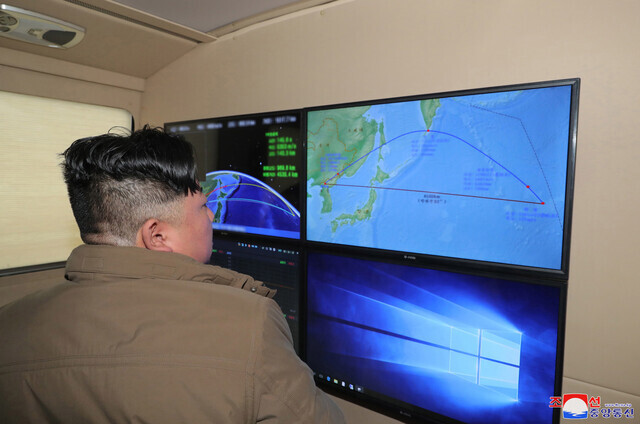hankyoreh
Links to other country sites 다른 나라 사이트 링크
N. Korea closes door to dialogue as it ramps up nuclear response posture

North Korean state media reported Monday that the North had conducted full-scale military exercises over the course of two weeks to mark the 77th anniversary of the founding of the Workers’ Party of Korea. North Korean leader Kim Jong-un, who had been in attendance at the military drills, referred to joint South Korea-US exercises as “further escalating the tension in the region.” He also expressed that he does not “feel the need” for dialogue, which is expected to increase tensions on the Korean Peninsula.
The North’s state-run Korean Central News Agency (KCNA) reported that Kim gave “on-the-spot” guidance at comprehensive air-attack drills, combined artillery/air force strike drills, and tactical nuclear operation unit drills from Sept. 25 to Oct. 9.
In particular, the KCNA claimed that North Korea carried out fighter jet exercises not reported by South Korea, in addition to firing a submarine-launched ballistic missile (SLBM) and a new intermediate-range ballistic missile (IRBM).
The news agency described the drill, which consisted of 150 fighter jets flying simultaneously in formation, as being carried out “for the first time in history.” As this drill took place, the South Korean military reportedly scrambled F-35A stealth fighter jets.
In addition, North Korea claimed to have fired an SLBM from an underwater launch silo in a reservoir in the country’s northwest on Sept. 25. At the time, the South Korean military determined that the missile was a short-range ballistic missile launched from the ground. The KCNA also claimed that the surface-to-surface IRBM launched on Oct. 4 was new, saying that the North “took a measure to hit the set water area in the Pacific 4,500 kilometers across the Japanese Islands.”
Kim also shut down the possibility of inter-Korean and North Korea-US dialogue.
The KCNA quoted Kim as saying, “Even though the enemy continues to talk about dialogue and negotiations, we do not have anything to talk about nor do we feel the need to do so.”
“The U.S. and the South Korean regime’s steady, intentional and irresponsible acts of escalating the tension will only invite our greater reaction, and we are always and strictly watching the situation crisis,” the North’s leader reportedly said, adding that Pyongyang would maintain its “strongest nuclear response posture and further strengthen it in every way.”
Kim’s remarks are being interpreted as a refusal to engage with South Korean President Yoon Suk-yeol’s “audacious initiative” to provide economic support to the North contingent upon its participation in denuclearization negotiations, as well as hinting that the North will undertake additional measures to strengthen its nuclear and missile capabilities, including a possible seventh nuclear test.
The South Korean presidential office criticized North Korea, commenting on the severity of the current security situation on the peninsula.
“North Korea is attempting to harm the lives and safety of the South Korean people with nuclear and missile threats,” said an official from the presidential office, who added that South Korea will thoroughly prepare for such dangers. The presidential National Security Council, which convened after North Korea’s short-range missile launch on Sunday, said, “North Korea’s continued provocations may instead make the regime more unstable,” in direct reference to Kim.
Tensions on the Korean Peninsula are expected to rise as the two Koreas continue to respond to each other tit for tat.
Yang Moo-jin, a professor at the University of North Korean Studies, said, “Depending on how South Korea and the US respond, North Korea is likely to engage in a two-stage show of force with the most powerful means being a nuclear test.” Yang also said that if North Korea does conduct a nuclear test, dialogue is most likely to be delayed even further.
By Jung In-hwan, staff reporter
Please direct questions or comments to [english@hani.co.kr]

Editorial・opinion
![[Editorial] Penalties for airing allegations against Korea’s first lady endanger free press [Editorial] Penalties for airing allegations against Korea’s first lady endanger free press](https://flexible.img.hani.co.kr/flexible/normal/500/300/imgdb/original/2024/0502/1817146398095106.jpg) [Editorial] Penalties for airing allegations against Korea’s first lady endanger free press
[Editorial] Penalties for airing allegations against Korea’s first lady endanger free press![[Editorial] Yoon must halt procurement of SM-3 interceptor missiles [Editorial] Yoon must halt procurement of SM-3 interceptor missiles](https://flexible.img.hani.co.kr/flexible/normal/500/300/imgdb/child/2024/0501/17145495551605_1717145495195344.jpg) [Editorial] Yoon must halt procurement of SM-3 interceptor missiles
[Editorial] Yoon must halt procurement of SM-3 interceptor missiles- [Guest essay] Maybe Korea’s rapid population decline is an opportunity, not a crisis
- [Column] Can Yoon steer diplomacy with Russia, China back on track?
- [Column] Season 2 of special prosecutor probe may be coming to Korea soon
- [Column] Park Geun-hye déjà vu in Yoon Suk-yeol
- [Editorial] New weight of N. Korea’s nuclear threats makes dialogue all the more urgent
- [Guest essay] The real reason Korea’s new right wants to dub Rhee a founding father
- [Column] ‘Choson’: Is it time we start referring to N. Korea in its own terms?
- [Editorial] Japan’s rewriting of history with Korea has gone too far
Most viewed articles
- 1Months and months of overdue wages are pushing migrant workers in Korea into debt
- 2Bills for Itaewon crush inquiry, special counsel probe into Marine’s death pass National Assembly
- 31 in 3 S. Korean security experts support nuclear armament, CSIS finds
- 4Trump asks why US would defend Korea, hints at hiking Seoul’s defense cost burden
- 5[Reporter’s notebook] In Min’s world, she’s the artist — and NewJeans is her art
- 6S. Korea discusses participation in defense development with AUKUS alliance
- 760% of young Koreans see no need to have kids after marriage
- 8[Editorial] Penalties for airing allegations against Korea’s first lady endanger free press
- 9[Column] Can Yoon steer diplomacy with Russia, China back on track?
- 10Vietnamese war victims speak of sexual violence by S. Korean troops for the first time